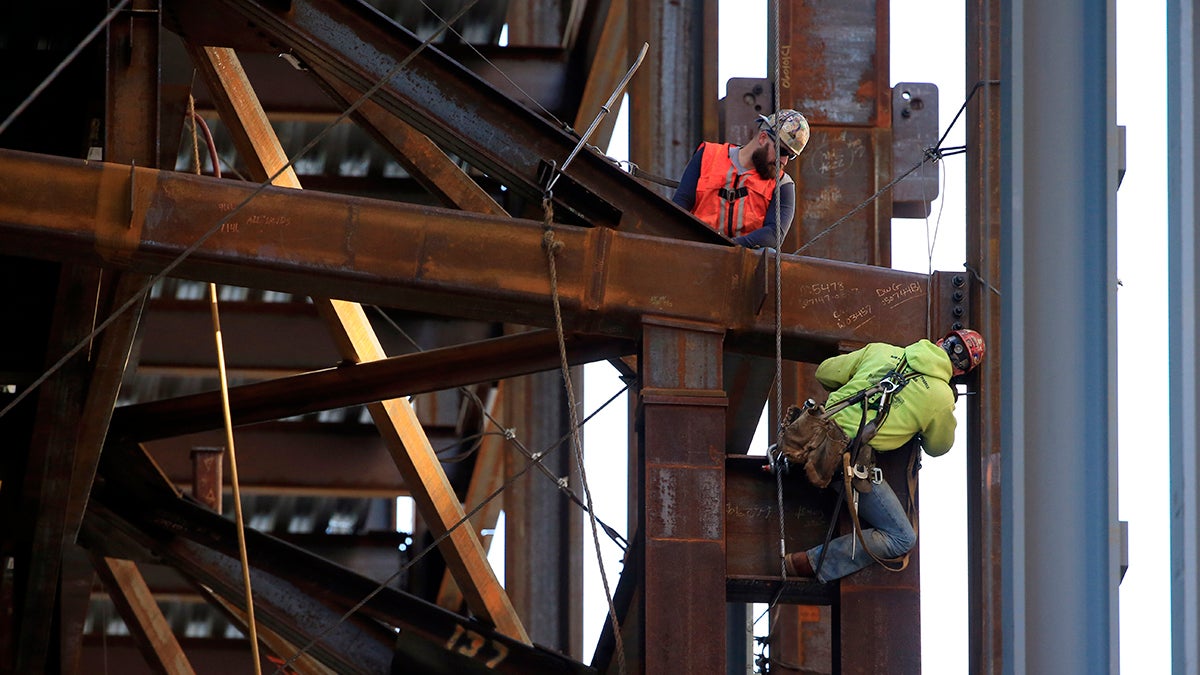Housing market cooling off in Philadelphia, Pittsburgh

Job growth is a primary driver of the housing market. In this Oct. 3, 2015 file photo, iron workers help build the Comcast Innovation and Technology Center in Philadelphia. (AP Photo/Matt Rourke)
Despite a drop in new units and prices, continued growth expected in the long run.
The demand for new apartments in Philadelphia and Pittsburgh has grown swiftly over the last few years. Developers have met that demand with a tremendous amount of construction, said Barbara Byrne Denham, senior economist at Reis, a real estate data and analytics company based in New York.
It might seem like both cities have more new luxury apartments than they know what to do with. But is hand-wringing about a housing glut a wise reaction?
“Yes and no,” said Byrne Denham.
One way to gauge the health of the housing market is to look at vacancy rates, which declined in Philadelphia between 2015 and 2016, moving from 4 to 3.6 percent. Byrne Denham anticipates vacancy will rise to over 4 percent in 2017, due to a sharp increase in overall construction, but she said it’s still a very low number.
On the other side of the state, the vacancy rate in Pittsburgh rose from 4.7 to 5.2 percent in the same period.
“While that looks striking, it’s not alarming,” said Bryne Denham, noting that new construction in Pittsburgh for 2017 is expected to drop by almost a third, to roughly 1,000 units. “So we do see a lot of supply, but it’s not such an alarming rate that we’re going to see empty, empty buildings.”
Doug Herold is director of Integra Realty Resources Pittsburgh, a real estate appraisal company. When he surveyed buildings in January, he found that absorption rates were fairly high, in other words, that units were being snapped up quickly. The market had significant pent-up demand from years of low development, he said.
“That indicated to me, at least back in January, that we were still working through pent-up demand. The big question is when are we done with the pent-up demand?”
After steady rent increases in Pittsburgh over the last four years, Michael Mele said average prices are now dropping, stabilizing at a new point. Mele is a data scientist at Pittsburgh-based RentJungle.com, a search engine for millions of rental properties in the U.S.
Most northern cities see a seasonal undulation in rental prices: lower in winter months, when no one wants to drive a moving van in the snow, and higher in the summer, said Mele. In recent years, Pittsburgh’s rental market has been strong enough to evade that seasonal effect.
“Prices continue to grow and are relatively unaffected by the season. That changed this past winter. We saw, for the first time in a couple years, the winter seasonal drop in prices. And it was a rather significant drop, a couple hundred dollars on average.”
It takes a while for supply and demand to agree on how valuable any given apartment is, said Mele, and in Pittsburgh, part of that negotiation might be due to a flood of new developers.
“It could be new blood coming into the market, not knowing exactly where to put their initial pricing,” he said. “They saw the market was paying $1,300 and they said, ‘Well, ours is shiny and new, so let’s make it $1,600, and the market didn’t respond as well.”
Bryne Denham suggests taking the long view on housing in Philadelphia and Pittsburgh.
“The big driver for occupancy is job growth. Philadelphia in particular has had pretty strong job growth, and we see that continuing this year,” she said, noting that in the Philadelphia [metropolitan statistical area], jobs grew by 1.9 percent from 2016 to 2017; in Pittsburgh that number was 0.1 percent.
Reis forecasts show positive job growth in both metropolitan areas, said Bryne Dehnam; as long as there’s an expectation of job growth, the apartment market should stay healthy.
WHYY is your source for fact-based, in-depth journalism and information. As a nonprofit organization, we rely on financial support from readers like you. Please give today.


